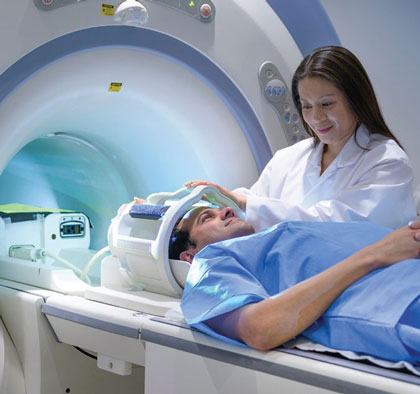Diagnosing MS and Evaluating Disease Activity
 Diagnosing and evaluating MS disease activity is most reliably done by neurologists through a neurological history and examination. Tests that can indicate MS and rule out “MS mimickers” (other diseases that resemble MS but have other causes) are also performed.
Diagnosing and evaluating MS disease activity is most reliably done by neurologists through a neurological history and examination. Tests that can indicate MS and rule out “MS mimickers” (other diseases that resemble MS but have other causes) are also performed.
Lesions (areas of inflammation and myelin damage in the brain and/or spine) may be viewed on a magnetic resonance imaging (MRI) scan. The MRI uses a computer, radiofrequency stimulator, and a large electromagnet to provide a picture of the brain and/or spine. While the picture looks a bit like an x-ray, it uses a different technology to show other details, and the MRI does not expose the patient to any radiation.
For people with multiple sclerosis, the MRI is used to evaluate the size and location of lesions. Inflammation can be better evaluated with gadolinium (or contrast) enhancement – a type of dye given to the patient via injection prior to the procedure. The MRI, particularly with gadolinium enhancement, allows doctors to measure disease activity within the central nervous system (brain, optic nerves, and spinal cord).
 Test results can help determine the effectiveness of a disease-modifying therapy (DMT), or to get an “inside view” of a patient’s disease status.
Test results can help determine the effectiveness of a disease-modifying therapy (DMT), or to get an “inside view” of a patient’s disease status.
Another tool that is sometimes used in the diagnosis of MS is a lumbar puncture (also known as a spinal tap). This is a procedure where a very thin needle is inserted at the base of the spine and a small amount of cerebrospinal fluid (CSF) is collected. CSF is the liquid that surrounds the brain and spinal cord. By collecting a small amount of this fluid, laboratory testing may be performed to evaluate cellular and chemical abnormalities. However, even if no evidence of MS is found in the CSF, this does not rule out MS as a possible diagnosis.
Evoked potential (EP) tests may also be used to help diagnose MS, if further support is needed. These measure the speed of the brain’s response to visual, auditory (sound), or sensory (feeling) stimuli, using electrodes taped to the patient’s head. Delayed responses can indicate possible damage to the nerve pathways.
Additional tools are available to measure disease activity. These are used mainly in clinical trials to help evaluate disease progression as well as changes in specific symptoms, such as fatigue, strength, mobility, vision, cognition, and others. The most widely known scale among the MS community is the Kurtzke Expanded Disability Status Scale (EDSS). It uses whole and half numbers from one to 10 to measure degree of disability, largely in terms of mobility.
Another measurement system is the MS Functional Composite (MSFC) scale. This measures lower-extremity function with a Timed 25-Foot Walk (T25-FW), upper-extremity function through the 9-Hole Peg Test (9-HPT), and cognitive function, using the Paced Auditory Serial Additions Test (PASAT).
